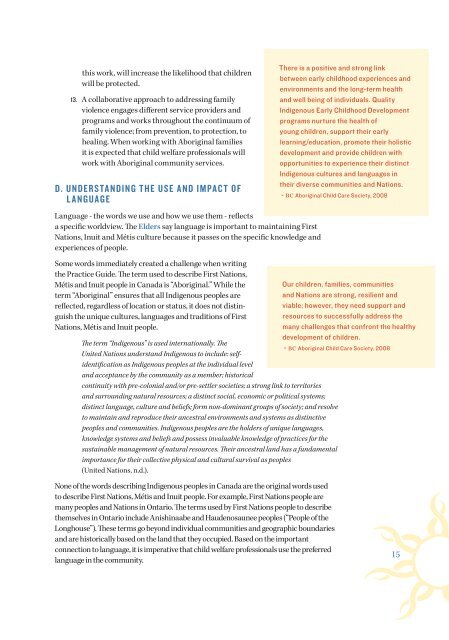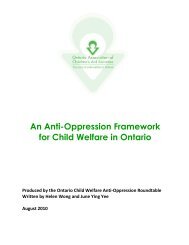English - Ontario Association of Children's Aid Societies
English - Ontario Association of Children's Aid Societies
English - Ontario Association of Children's Aid Societies
Create successful ePaper yourself
Turn your PDF publications into a flip-book with our unique Google optimized e-Paper software.
this work, will increase the likelihood that children<br />
will be protected.<br />
13. A collaborative approach to addressing family<br />
violence engages different service providers and<br />
programs and works throughout the continuum <strong>of</strong><br />
family violence; from prevention, to protection, to<br />
healing. When working with Aboriginal families<br />
it is expected that child welfare pr<strong>of</strong>essionals will<br />
work with Aboriginal community services.<br />
D. UNDERSTANDING THE USE AND IMPACT OF<br />
LANGUAGE<br />
Language - the words we use and how we use them - reflects<br />
a specific worldview. The Elders say language is important to maintaining First<br />
Nations, Inuit and Métis culture because it passes on the specific knowledge and<br />
experiences <strong>of</strong> people.<br />
Some words immediately created a challenge when writing<br />
the Practice Guide. The term used to describe First Nations,<br />
Métis and Inuit people in Canada is “Aboriginal.” While the<br />
term “Aboriginal” ensures that all Indigenous peoples are<br />
reflected, regardless <strong>of</strong> location or status, it does not distinguish<br />
the unique cultures, languages and traditions <strong>of</strong> First<br />
Nations, Métis and Inuit people.<br />
The term “Indigenous” is used internationally. The<br />
United Nations understand Indigenous to include: selfidentification<br />
as Indigenous peoples at the individual level<br />
and acceptance by the community as a member; historical<br />
continuity with pre-colonial and/or pre-settler societies; a strong link to territories<br />
and surrounding natural resources; a distinct social, economic or political systems;<br />
distinct language, culture and beliefs; form non-dominant groups <strong>of</strong> society; and resolve<br />
to maintain and reproduce their ancestral environments and systems as distinctive<br />
peoples and communities. Indigenous peoples are the holders <strong>of</strong> unique languages,<br />
knowledge systems and beliefs and possess invaluable knowledge <strong>of</strong> practices for the<br />
sustainable management <strong>of</strong> natural resources. Their ancestral land has a fundamental<br />
importance for their collective physical and cultural survival as peoples<br />
(United Nations, n.d.).<br />
There is a positive and strong link<br />
between early childhood experiences and<br />
environments and the long-term health<br />
and well being <strong>of</strong> individuals. Quality<br />
Indigenous Early Childhood Development<br />
programs nurture the health <strong>of</strong><br />
young children, support their early<br />
learning/education, promote their holistic<br />
development and provide children with<br />
opportunities to experience their distinct<br />
Indigenous cultures and languages in<br />
their diverse communities and Nations.<br />
- BC Aboriginal Child Care Society, 2008<br />
Our children, families, communities<br />
and Nations are strong, resilient and<br />
viable; however, they need support and<br />
resources to successfully address the<br />
many challenges that confront the healthy<br />
development <strong>of</strong> children.<br />
- BC Aboriginal Child Care Society, 2008<br />
None <strong>of</strong> the words describing Indigenous peoples in Canada are the original words used<br />
to describe First Nations, Métis and Inuit people. For example, First Nations people are<br />
many peoples and Nations in <strong>Ontario</strong>. The terms used by First Nations people to describe<br />
themselves in <strong>Ontario</strong> include Anishinaabe and Haudenosaunee peoples (“People <strong>of</strong> the<br />
Longhouse”). These terms go beyond individual communities and geographic boundaries<br />
and are historically based on the land that they occupied. Based on the important<br />
connection to language, it is imperative that child welfare pr<strong>of</strong>essionals use the preferred<br />
language in the community.<br />
15

















